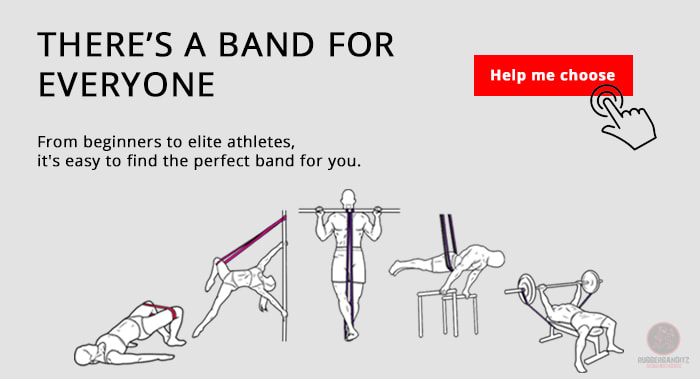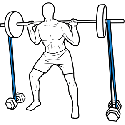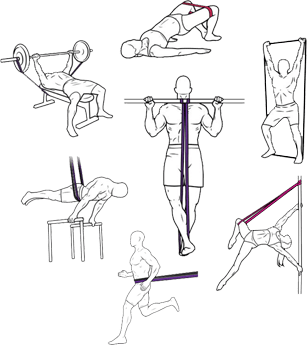Resistance bands are an easy, effective, and affordable way to add variety to your workout routine. You can add a plethora of full body conditioning exercises with a resistance band workout in the great outdoors. Try exploring other options if you find yourself uncomfortable in a noisy, crowded, or intimidating gym. Take your resistance band to your favorite park, trail, or yard.
Let’s start with the benefits of resistance bands. The bands help strengthen muscles by adding resistance or tension to muscle movements, similar to the way weights do only adding less stress on your joints. They’re lightweight and portable, so you don’t have to worry about lugging around heavy or bulky equipment. This makes them perfect for travel or outdoor workouts. They’re also easy on your wallet, especially when compared to solid iron.
Another huge benefit is that resistance bands are suitable for all fitness levels, from beginners to elite athletes. Additionally, many medical professionals proscribe resistance band workouts for their patients who are recovering from surgery or a stroke. As your fitness level increases, you can increase the resistance level by using or by combining several bands. In general, the thicker the band, the more resistance it will provide.
Switching out free weights for resistance bands can save you from post-workout joint pain. Weights use gravity to create resistance. The lifting and lowering of weights strengthen muscles, but it also puts a lot of pressure on your joints. Resistance bands rely on the elastic force of the band to create resistance. This puts a lot less pressure on your joints, while still helping you strengthen and tone your body in a similar fashion.
The difference between free weights and resistance bands involves momentum. Gravity forces weights in one direction (down). You have to stop that downward momentum at the bottom or end of the exercise. This can overextend joints, strain or tear muscles, and cause injuries. This is an issue, especially for beginners who may not be familiar with proper form when using weights. Form is also important when using resistance bands, but it’s easier to maintain good form when using bands because you have to constantly engage your core to stabilize yourself. This provides the dual benefit of strengthening both the core and primary muscle groups at the same time.
Resistance bands also open up new reals of possibilities and a whole series of different exercises you can do. Because free weights depend on gravity, they provide the most resistance on a vertical plane (up and down). Resistance bands offer resistance at many different angles and vectors. Plus, it’s much easier to bring resistance bands on-the-road or outside with your kids.
Getting outdoors has many benefits for the mind, body, and soul. You get the stress-relieving benefits of fresh air and sights and sounds of nature, a boost to your immune system, and a dose of Vitamin D from the sun’s UV-B rays. Adding exercise to the mix is even better. If you’ve taken the time to move your routine outside, you might stick with it longer to make the trip worthwhile. Whether you’re walking, running, practicing yoga, or doing a full-body strength-training routine, resistance bands will help maximize your efforts.
A good workout starts with a good warm-up, and loop-style resistance bands offer effective warm-up moves for any type of outdoor exercise. The purpose of your warm-up routine is to gradually raise your body temperature. This increases flexibility and mobility and warms up the synovial (lubricating) fluid for your joints, so they aren’t stiff. Warming up prepares your body for exercise and prevents injuries. While it may be tempting to skip the warm-up, especially if you’re short on time, it’s essential to include it as part of your workout.
Keep in mind, you’ll need a variety of sizes for stretching each part of your body and for each exercise. A combo band set of our resistance bands will have what you need for stretching, pull-ups
It’s best to do these moves with muscles that are already slightly warm, so consider taking a short walk or jog before starting. Another option is to start with a few repetitions without your resistance band, then add the band.
Warm-Up Exercises
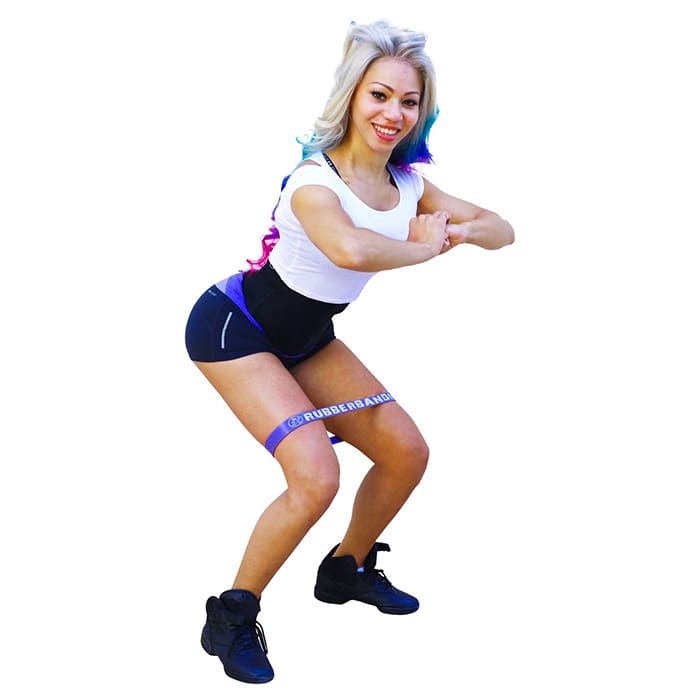
- Squats - This is the quintessential exercise to increase lower body strength. Put your resistance band around your thighs, a few inches above your knees. With feet shoulder-width apart, bend your legs and lower your body like you’re sitting in a chair. Keep torso upright and make sure knees don’t extend beyond your toes. Return to starting position, and repeat for a set of 10.
- Ankle jumping jacks - This is a mini-jumping jack with a mini loop resistance band around your ankles (we recommend the lightest one). Start with feet together, then jump while separating feet farther apart than shoulder-width. You can raise your arms over your head or raise them halfway. Repeat for 20-30 seconds, rest briefly, and repeat until you start to lightly sweat. This move will get your heart rate going while strengthening your legs, core, and back muscles.
- Lateral walks - Place the resistance band around your ankles or thighs. Start with feet shoulder-width apart, then move to a half-squat. Take small steps to the left, making sure to keep your back straight and your body weight centered over both feet. Return to center and repeat, taking small steps to the right. Do 8-10 steps in each direction, working up to three sets. This exercise works your glutes, hips, and thighs, and can increase the stability of your knee joints. Note, if you’re comfortable you can also do resistance band lateral walk going up and downstairs.
- Band pull apart - Extend both arms in front of you, holding your band in both hands with palms down. Move hands laterally out to your sides, in a reverse fly motion. Bring the band to your chest while keeping your elbows extended. Slowly return arms to starting position. Start with 10 reps, working up to three sets of 10.
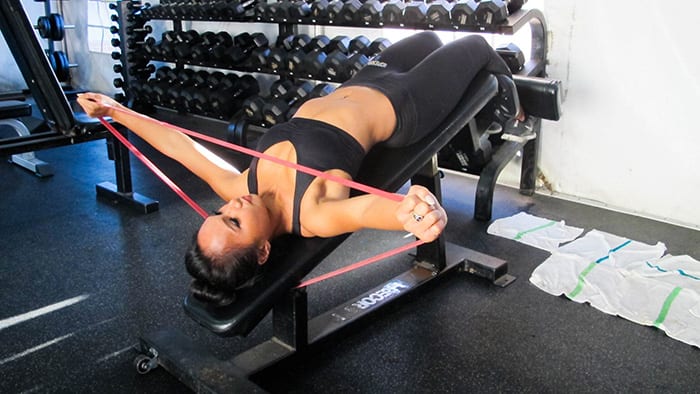
Again, It's crucial to warm up immediately before your workout. If too much time elapses between your warm-up and your workout, you’ll lose the benefit of warm muscles and a body ready for exercise.
Now that you’re warmed up, keep your resistance bands within reach for the rest of your workout. You can add resistance-band stretches at intervals during a walk or run. Banded squats and lateral walks are good choices. There are plenty of exercises you can do on the track or along the trail.
Here are a few workout band exercise you can do anywhere with nothing else except you and the band:
- Standing hip extension - Place a resistance band around your ankles and transfer your weight to one foot. Hold onto a park bench, wall, or light pole if you need help with balance. Extend free leg straight behind you as far as you can, then return to starting position. Do 8-10 reps on each leg, working up to 3-5 reps. This exercise strengthens glutes and hamstrings.
- Reverse lunges - Hold the ends of your resistance band in each hand, bending elbows at your sides at a 90-degree angle. Step on the middle of the band with one foot. Take a large step back with the other foot, lowering your body until your front thigh is parallel with the floor. Make sure your back is straight and your front knee is over your ankle. Return to starting position. Repeat 8-12 times on each side. Lunges work your glutes, hamstrings, quadriceps, and core muscles.
- Banded row - Step on the resistance band with one foot and hold the band with your hand on that same side. Move the other foot behind you, with your foot on the ground in a diagonal, toe pointing out position. Bend your front leg and lean forward. Pull the arm holding the band up, hugging your elbow close to your side and squeezing your shoulder blade toward your spine. Continue pulling and releasing 10 times, then switch sides.
- Overhead press - Stand with your feet slightly apart, and place a resistance band around your wrists. Separate arms to create some tension in the band, then raise arms toward the sky. Lower arms with control to starting position. Repeat 10-15 times.
Yoga is another excellent choice for outdoor exercise. Go deeper into your yoga-in-the-park poses by performing your favorites with a yoga band. Here are a few ideas for inspiration:
Yoga
- Chair pose - Step on a looped resistance band with both feet, with feet shoulder-width apart. Hold the top of the band in both hands, with arms also shoulder-width apart. Inhale and raise your arms overhead, elbows by your ears. Exhale and bend your legs, lowering your body as if you're lowering yourself into a chair. Hold the pose for 30 seconds to one minute, then return to starting position.
- Warrior II pose - Hold one end of the resistance band in each hand and move into Warrior II pose, stretching the band with your arms. Another option is to start in a Warrior II stance, stepping on the resistance band with your front foot. Hold the other end of the band with the opposite hand. Extend your other arm forward, and pull the arm holding the band back like you're pulling the drawstring to release an arrow from a bow. Return your arm to starting position. Repeat 10-12 times, then switch sides.
- Bridge pose - Lie down on your mat and place a resistance band around your thighs, several inches above your knees. Bend your knees, bringing your heels toward your glutes. Keep your feet flat on the mat, shoulder-width apart, and separate your knees to create a slight tension in the band. Contract your abs and raise your hips toward the sky. Lower hips gently to the mat. Repeat 10-15 times.
- Banded side bend - Step on the resistance band with your right foot and hold it with your right hand. Begin to shorten the band while bending to the right side. You should feel your left waist lengthening. Pause and breathe, then return to standing. Repeat several times, then switch sides.
A few tips for outdoor yoga: Pick a dry and level area that's clear of debris (trash, animal waste, cigarette butts, etc.). Grass is ideal, but keep in mind you still may end up with dirt or dust on your mat and body. Some outdoor yogis also choose to wear yoga clothes that can get dirty.
You can also use resistance bands at the end of your workout for a cool-down and for stretching. Choose your favorite static stretch, adding a resistance band to help you get deeper into the stretch. Hold the stretch for 20 seconds or more. You’ll find using resistance bands can help you stretch hamstrings, quads, calves, shoulders and arms as you’re cooling down. Doing this will help increase flexibility and mobility while preventing post-workout soreness and stiffness.
Once you start your outdoor resistance band workout routine, you may find it hard to stop. Resistance bands are getting more popular as more people discover their effectiveness. So join the movement and move your workout outdoors, assisted by all the body-strengthening benefits the bands have to offer.
Laura Hatch is a journalist who spends her free time working out and hiking with her husband and three sons. From Pikes Peak in Colorado to the Great Smoky Mountains in Tennessee and McAfee Knob near Roanoke, she’s made it to the summit of the country’s favorites." She packs her resistance bands for her less challenging climbs to get a better workout. She prefers the Rubberbanditz booty band, because unlike some, it doesn’t break when she gives it a workout.



